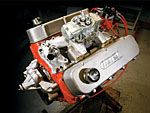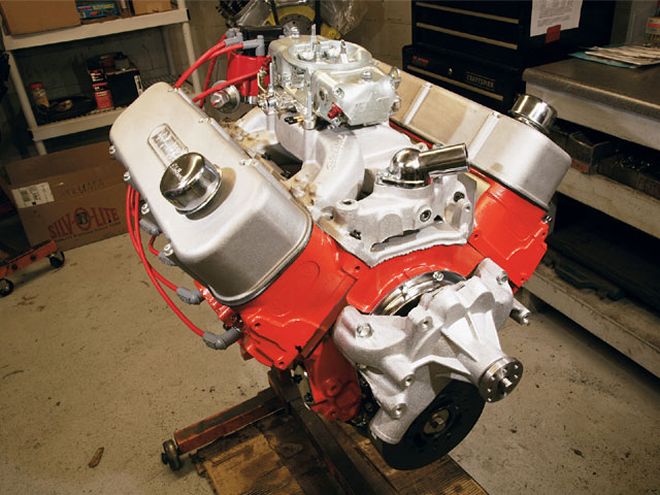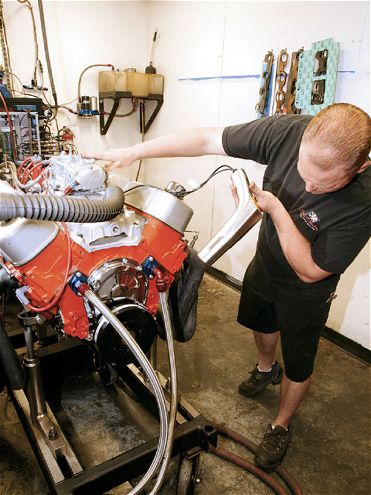
No doubt about it, building a big-block Chevy is a more expensive proposition than one of its small-block kin; however, many favor these engines because their easy power and bountiful cubes deliver dependable torque. In production form, the 454 is by far the most common member of the big-block family-an engine that earned a legendary reputation at the pinnacle of the factory muscle era. It has continued in more recent years as a sturdy workhorse in trucks, but back when musclecars ruled the streets, the LS6 454 was Chevy's top dog, with 450 gross horsepower from the factory. These days, most builds will be based upon the readily available late-model truck engine.
Build It
Starting at the foundation, any 454 engine block can serve as an excellent basis for a stout performance build. Later Mark V engine blocks actually featured improvements like a one-piece rear crankshaft seal, provisions for hydraulic roller cams, and a camshaft thrust plate, though some also did away with the machined pad for a mechanical fuel pump. Internally, some earlier engines came with a forged crankshaft and high compression pistons; however, don't feel the need to hunt down the rare factory performance stuff. The factory iron crank has proven to be remarkably reliable, and the pistons will be replaced in the course of a rebuild anyway. Our engine build is based on a common Mark IV engine core, and the plan for the bottom end is simple-a basic rebuild of the original equipment, as with any stock rebuild. Our only concession to the performance objectives of the engine would be to substitute higher compression pistons and a good set of rings.
We selected a set of KB hypereutectic pistons (UEM-KB207060-8), which feature a 0.250-inch hollow dome for a net volume of +25.5 cc. These pistons retail for a little more than standard replacement pistons, but the added compression ratio they provide is a welcome addition. These pistons are cut for 1/16-inch compression rings, which reduces friction compared to the 5/64-inch stockers. We didn't skimp when it came time to fill the grooves, selecting a quality Total Seal moly ring set. Moly rings are worthwhile in any build, offering reduced friction and improved sealing and bore life.
Other than the moderately upgraded pistons and rings, the rest of the bottom end received nothing but a standard rebuild. The block was cleaned, inspected, and machined by Speed-O-Motive, including boring and honing to size, and decking to zero deck with our choice of KB pistons. Since our production iron crank was in terrific condition and checked out fine, it was simply given a polish and balanced for the new pistons. The factory rods were resized and retained the stock bolts, and the KB pistons were installed as a press-fit on the rods.
Power Parts
There was definitely nothing exotic about the basic bottom end of the engine-just your everyday 454 with a bump in piston spec. These KB pistons would be enough to provide a compression ratio of more than 10:1, but that alone wouldn't add much greater power than a plain old truck 454. To step things up, power parts needed to be included in the mix, and first on that list was the camshaft. Later 454 engines came from the factory with hydraulic roller cams, but to take things to the next level, we went with a solid roller. A solid cam provides much improved high-rpm stability, particularly with the OEM big-block's heavy valvetrain. No, we weren't after a wild drag race roller, but a moderate street roller, and we looked no further than COMP Cams for one of their Xtreme Energy Street Roller grinds.
With a single-pattern stick cut on COMP's No. 4874 lobes, lobe separation came in at 108 degrees. The tight center and fast roller cam action helped torque come up hard and fast. With 242 degrees of duration at .050-inch lift, the cam timing is not excessive, striking a good balance between power and driveability. In combination with the big Chevy's 1.7:1 rocker ratio, the valve lift is substantial, translating to .647-inch gross lift at the valves.
So our 454 project was turning into a stocker with higher compression pistons and a fairly substantial cam. While those factors would aid in our power plans, it was going to take more than that to breathe some life into those inches. Cylinder heads are also key players. The original high-performance big-blocks came with monstrous rectangular port heads, but unfortunately, you won't find a set of those on a later truck engine core. In fact, chances are you won't find a good oval-port set either, since many of these engines were produced with the dreaded "peanut-port" heads. Don't expect to flow much power through that tortured iron.
The solution in such a case is to upgrade with more suitable castings. We liked the idea of rummaging around for vintage rectangular-port heads, or even good oval ports, but this desirable iron is getting difficult to find. Vintage big-port heads at bargain prices are rare, and we definitely planned on a full rebuild, along with serious grinding and port work, if we did score a set. Realistically, all of this scavenging and reworking comes at its own price, which starts to add up in time and money. Tally in the seat work, new guides, spring seat machining, new valves, seals, and all the rest, top it with the porting time and supplies for a full port and polish job, and the cost of those vintage castings escalates quickly, even if we could find them.
You might call us lazy, but we just gave up on the heroics of dirt-cheap ported stock iron, and ordered up a fresh set of replacement castings from Summit Racing. These heads feature 308cc rectangular ports, with 2.250-inch intake valves and 1.88-inch exhaust valves. More importantly, they are brand new and ready to run. With 330 to 355 cfm of intake flow, these cylinder heads will outflow any of the stock iron by a substantial margin. The Summit heads definitely save on time scrounging for the "good" OEM iron, and maybe even more time and money in trying to make them "better" with all the rebuilding and porting that's bound to follow.
With the addition of the Summit iron heads, we had our basics in place. To some, it might appear a fairly bare-bones effort-and it is. At this point, there was little to differentiate our engine from any rebuilt truck motor (other than a modest bump in piston spec, a hot cam, and replacement iron heads). Of course, there is the supporting cast of characters required to complete the transformation to a righteous high-performance powerplant. The cam needs support with accompanying parts-good pushrods, rockers, and springs for starters. Here, we upgraded with all of the required components straight out of the COMP catalog. Up top, our bare long-block needed a matching ensemble, and there are quite a few choices in inductions. We opted for Edelbrock's Performer RPM Air-Gap two-plane intake manifold, a reliable power-maker in applications to around 600 hp. A Mighty Demon 800 carb finished off the induction combination.
Number Crunching
With the basic nature of our .060-over 454 build, the assembly was not much more complex than wrenching together a stocker. All told, once dressed-up in a coat of Dupli-Color Chevy Orange paint, Dart cast-aluminum valve covers, and loaded on the dyno at Speed-O-Motive, our 454 had the looks of a solid hot street mill. Fired up and loping at an idle, the solid roller COMP cam definitely exhibited a noticeable thump, though the idle quality was far from outrageous. Thank the conservative cam timing for that. After the required warm-up and break-in period, the final hot valve-lash settings were confirmed and adjusted as required, and the base timing was set to a conservative 34 degrees. Next, dyno operator Jake Hairston methodically dialed-in the air/fuel ratio and we were ready to let the rpm roll for the numbers. Within minutes, we had the output quantified with 579 peak horsepower coming in at 6,200 rpm, and a stout 545 lb-ft of torque at 4,100 rpm.
This big-block certainly generated the torque these engines are known for, coming on hard right at the bottom of the pull, and cresting the 500 lb-ft mark by 3,000 rpm. That's 500 lb-ft right off the go with any reasonable street torque converter, and without a doubt, a full and fat torque curve like this is sure to provide axle-ripping, sideways street action when the hammer is dropped. We could have tuned in more power higher in the curve, in search of the added 21 hp that would give us 600hp bragging rights, and a single-plane or tall spacer and another couple of hundred extra cfm of carb capacity would likely have nudged the top-end power curve skyward. There would be a price to pay, though, in raw low-end torque. When it comes to a street application, torque rules the road. A sky-high induction would also foil any stock flat-hood plan, so we stuck with the lower rise intake and reaped its rewards in torque and stealth.

Speed-O-Motive Crate Motor
We realize not everyone has the time or ability to build a 468ci big-block in their garage, in which case you might be interested to know that this exact engine can be ordered as a crate motor from Speed-O-Motive in West Covina, California. The entire package is $8,500, including dyno time. The only substitution is that Speed-O-Motive will use Dart Iron Eagle heads, which are identical to the Summit pieces in our story. (Dart builds and assembles the Summit heads, then engraves them with the Summit Racing logo. When spec'ing out headers, or anything else, use the Dart Iron Eagle guidesheet for the 308cc runner version.) As a point of reference, $8,500 is about the same as the street price for a GM ZZ502 crate motor, which makes 502 hp at 5,200 rpm. To find out more, call Speed-O-Motive at 626-869-0270.
On The Dyno
468-inch Ironman big-block Chevy 2-inch long-tube test headers DTS Engine Dyno Tested at Speed-O-Motive
 RPM TQ HP 3,000 502 286 3,{{{200}}} 523 318 3,400 532 344 3,{{{600}}} 536 367 3,800 541 392 4,000 543 413 4,200 545 435 4,400 538 451 4,600 536 469 4,800 535 489 5,000 529 504 5,200 527 522 5,400 523 538 5,600 519 554 5,800 512 565 6,000 {{{505}}} 577 6,200 490 579 6,400 472 575
RPM TQ HP 3,000 502 286 3,{{{200}}} 523 318 3,400 532 344 3,{{{600}}} 536 367 3,800 541 392 4,000 543 413 4,200 545 435 4,400 538 451 4,600 536 469 4,800 535 489 5,000 529 504 5,200 527 522 5,400 523 538 5,600 519 554 5,800 512 565 6,000 {{{505}}} 577 6,200 490 579 6,400 472 575